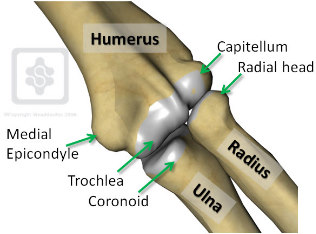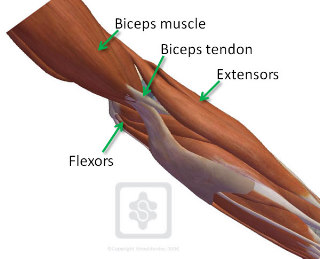Elbow Anatomy
The elbow is the joint that bends your arm. It helps you to lift and move objects. It is a modified hinge joint made up of three bones. These are the humerus (bone of the upper arm) and the forearm bones, known as the radius and ulna.
The link between the humerus and the two forearm bones is the main elbow joint, which bends and straightens the arm. The link between the radius and ulna allows the forearm to twist, turning your palm up or down.

Many important muscles cross the elbow joint, providing the movement and strength. The main bending muscle is the biceps and the straightening muscle is the triceps. The biceps tendon is prone to rupture, but this is unusual with the triceps.
The forearm muscles are those which lift the wrist and hand up (known as extensors) or bend it down (known as flexors). Chronic pain of the extensors at the elbow is known as 'tennis elbow' and chronic pain of the flexors is called 'golfers elbow'.

The elbow is stabilised by some very important ligaments (collaterals), which can be damaged from a fall or repetitive sports, such as Baseball pitching. This can lead to elbow instability.
The important nerves of the elbow are the ulnar, median and radial nerves. They can get trapped by fibrous bands or damaged from injury. This leads to pain, weakness and numbness in certain parts of the hand and wrist.


